Nathan McGuinness has over 20 years experience in visual effects. He founded the studio Asylum in 1999 where he has worked on films such as Pearl Harbor, Black Hawk Down, Pirates of the Caribbean: At World’s End and The Curious Case of Benjamin Button. When Asylum closes in 2011, he joins the DNEG team and has worked on projects such as Battleship, Total Recall, Furious 6 and Westworld.
Pete Bebb started his career in visual effects more than 20 years ago at DNEG for the movie Pitch Black! He then worked on a many films including The Chronicles of Riddick, The Dark Knight, Captain America: The First Avenger and Fantastic Beasts and Where to Find Them. He won an Oscar for Best Achievement in Visual Effects for Inception.
How did you and DNEG get involved in this show?
Nathan McGuinness // Aaron Ryder, Executive Producer at FilmNation who I have worked with on several projects in the past reached out as a 911. The project was in need of help not only from a visual but also a storytelling standpoint. The combination of helping create both story and vision excited me.
Pete Bebb // Mike [Chambers, VFX Producer] and Nathan are old friends to DNEG and they reached out to us to complete this show which was in trouble due to problems with a previous VFX vendor. The reliance on CG for narrative was significant and time was of the essence, and we saw it as a real challenge, not only from a logistical standpoint but also a creative one. Plus who in their right mind would turn down a Tom Hanks war film!
How was the collaboration with the filmmakers?
Nathan McGuinness // I had a very close and personal creative working relationship with Gary Goetzman, Producer Playtone, Tom Hanks, Writer / Main Character “Captain Krause” and Aaron Ryder, Executive Producer, FilmNation. My home base was at Playtone so that we were able to closely collaborate every step of the way during the create and storytelling process.
Pete Bebb // From a DNEG standpoint we predominantly dealt with Nathan and Mike. Nathan obviously liaised with the studio to be sure we were creatively on the right track and on target to deliver.
What were the filmmakers’ expectations and approach towards the visual effects?
Nathan McGuinness // The filmmakers were looking for a seamless photoreal environment to build the story of Captain Krause and Greyhound’s journey / battle at sea. The filmmakers looked to me for guidance to create environments not captured in camera given my extensive background in creating brutal battles environments at sea.
Pete Bebb // At the point we joined the production, the filmmakers had not seen much from VFX, hence the reason for us being approached to do the show. Consequently, once sequence layout, asset look development and early water FX tests started to come through it was all very much welcomed. Both Nathan’s and our approach were in tandem, very keen to keep the camera real world and the look authentic. For us this m/o was imperative. The fact they are visual effects shots should really bear no significance. If we have been involved from the start we would have no doubt approached shooting as much as we could in camera.
How did you organize the work between you two and your VFX Producer?
Nathan McGuinness // Mike Chambers, VFX Producer, not only managed the vendor – which given the schedule was an insurmountable task, he also was intricate in creating an environment where I could pre-vis, post-vis, edit, collaborate with sound design and color in order to streamline Greyhound’s journey that the VFX was able to create.
Pete Bebb // Regular video calls with Nathan and Mike happened most days as we structured a plan of attack for this show. In the meantime data was being requested from the previous vendor to aid in our workflow, but with time being limited there was a point by which this task was rendered redundant.
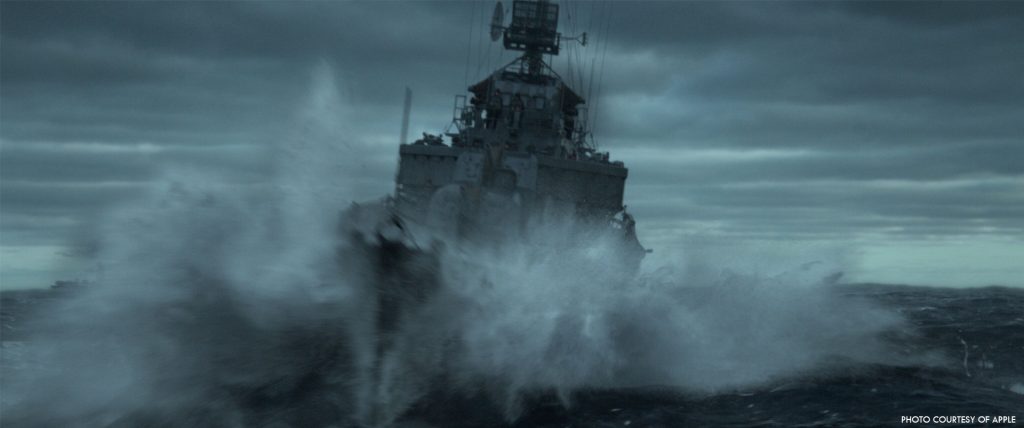
How did you split the work amongst you and the DNEG offices?
Nathan McGuinness // From my point of view I oversaw DNEG as one Vendo
Pete Bebb // From a DNEG perspective our London studio developed the look, lighting and FX for the show. Hero shots and set-ups were taken to final and then the ‘recipe’ so to speak, was sent to various DNEG offices around the world for execution.
The movie is taking place almost entirely on the ocean. What was your approach?
Nathan McGuinness // My first process was to re-create the path of Captain Kraus, The Alley Convoy as well as the German Submarines. I visualized their realtime nautical path and broke it down into multiple beats creating the storyline; environments / time of day / weather /battles /convoy tactics…. Once I had the full journey visualized I brought in a previs team to reenact a geographical chart of the number of ships and their path which was crucial because of their constant course correction during their journey across the Atlantic, knowing that each turn presented a different environment; sun, sea, horizon, boat position etc. Also of utmost importance was the choreography of the confrontations between the Grey Wolf, it’s Wolf Pack and the Greyhound. Gordon Laco, who was the naval consultant whom I have worked with previously, was key in helping setting the scenes to be true to history!
I also did a deep dive to catalogued old photography, film, voice recordings from WW2 creating an extensive library for reference making sure what was recreated was true to the event. As we were creating non existing plates I looked at each shot as if we were filming at sea – that vision along the pre-vis and the library I created for look development I was able to give clear creative direction. With the above mentioned combined with DNEG’s Sky Capture photography I was able to go shot by shot selecting an accurate time of day to hand hand off HDRI’s in order for DNEG to light accordingly. This was our foundation.
Pete Bebb // In light of time available, shooting any plates for this was long gone. The approach had to be full CG for the ocean and ships to allow us the flexibility and power to create multiple shots of guaranteed quality. The plates from New Orleans of the dry dock USS Kidd were good but we had a challenge to get the lighting to fit and of course ocean interactivity. Storms in the Atlantic tend to be far greyer and miserable to that of the New Orleans climate.
From extensive research and reference from Nathan and his team (including a naval advisor) we went about building various hero escort vessels and the convoy. What data could be retrieved from the previous vendor was utilised, but a lot had to be started from scratch to be compatible with our in-house pipeline.
Due to the nature of the film being a minute by minute account from the perspective of the Captain we knew we had to have weather that worked with each scene and flowed. Knowing this we used a bespoke system from DNEG called Sky Capture. Basically this is 10 stills cameras arranged in a hemisphere set up to record HDR images every few minutes. This system creates a very high resolution HDR time lapse footage that we used to light the various scenes. We sent teams to the coast around the UK so we could try and gain as much clean horizon photography as possible. A clean horizon line being key for the environment at sea. From these various lighting and sky captures internal selects were made for each scene and offered to the client for approval. Once Nathan was happy we developed a look for each sequence based off this set up. The ocean development was worked up in conjunction with this. Nathan advised us as to what level of Beaufort he wanted per scene. Ranging from Beaufort 2-3 all the way to 7-8. Beaufort scale determining the ocean conditions. A total of 5 ocean Beaufort scales were created.
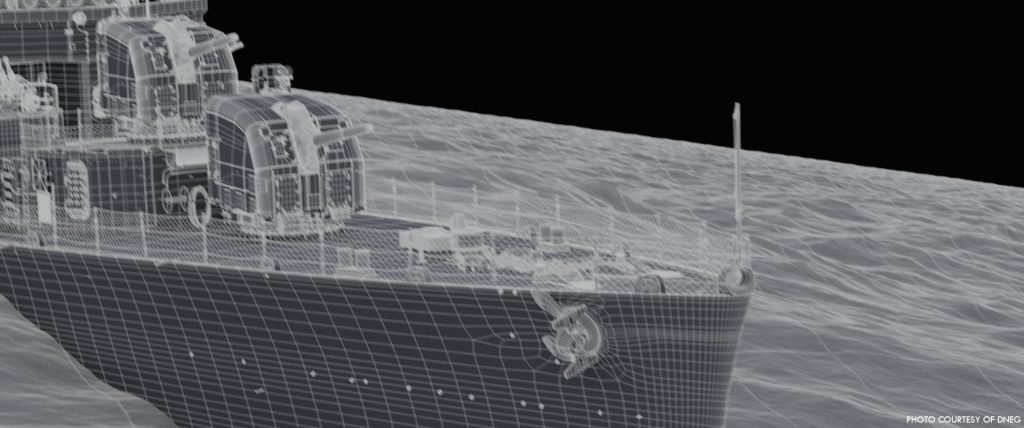
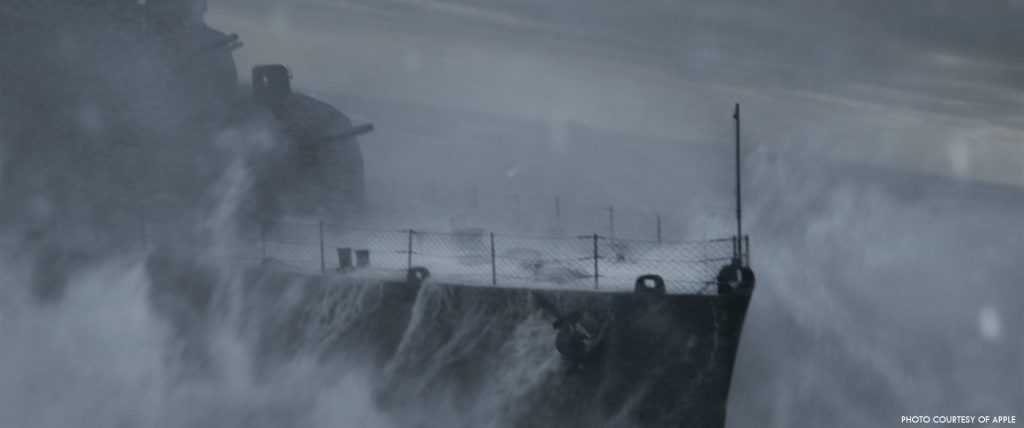
How did you use the Previs to organize the shooting and the post production?
Nathan McGuinness // I was not involved in the shooting process and there was little to nothing to use from it. My use of previs is explained above.
Pete Bebb // None of us including Nathan and Mike were involved in the shoot. Thus we did not have the opportunity to utilise previs through to techvis to design the shots. What you would typically expect from a VFX perspective from a shoot was not undertaken to our knowledge, rendering our job that much more difficult.
From a post production point of view we did undertake previs to design shots taking the approach of real camera work – boat to boat scenarios. Nathan was keen to maintain this level of realism as were we. Camera design is critical to the believability of this type of film.
In addition to this we used the beat by beat radar plans issued by production under the remit of the naval professional to determine the course of the scenes and how exactly the escorts convoy and U boats would react in certain scenarios. We mocked out all of these plans into one master scene in layout thus giving us shot by shot account for the entire film. You could essentially watch the entire film from a birds eye view.
Many shots are full CG. Were you able to submit ideas and suggestions for the Framing?
Nathan McGuinness // This was such an important part of my thought process. I put myself within each scene – man vs nature visualizing the POV; out sea, ship to ship, birds eye view, visuals of seaman and the german U-boats creeping under the ocean depths at sea. Seeing through Captain Krause eyes and researching scenarios was of utmost importance.
Pete Bebb // Yes absolutely – we designed certain shots based off how they may have been shot in the day. Ship to ship essentially or from a plane.
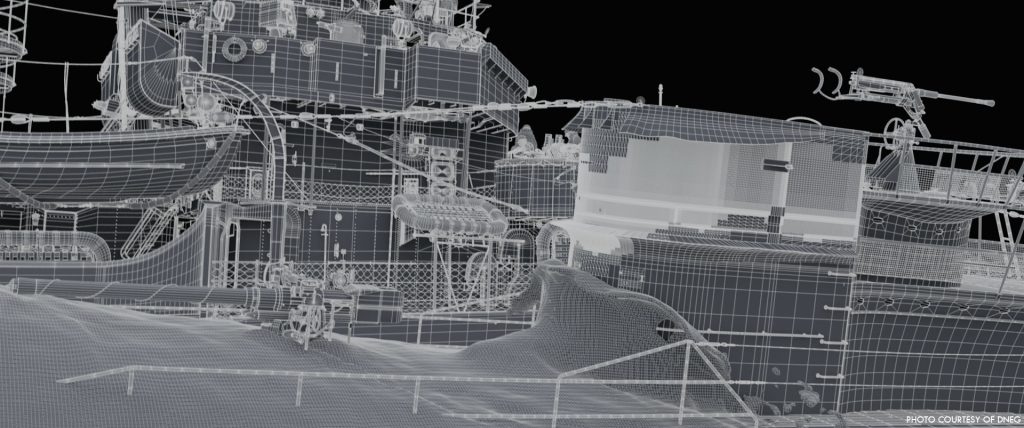
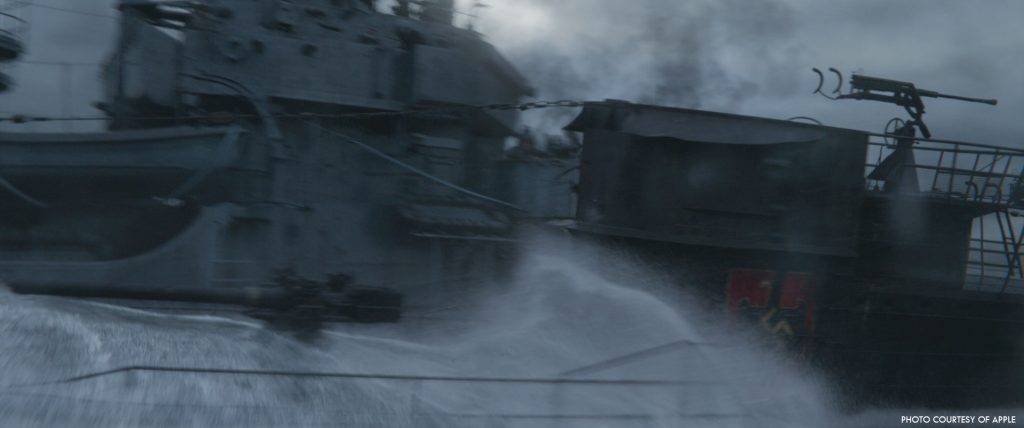
Can you elaborate in detail on the ocean creation and the water simulations?
Nathan McGuinness // I began researching real photography to represent the character and vengeance of the water for each scene (Beaufort scale). I provided the photography as a guide to match the temperament of the ocean for each shot. Providing Pete with visual’s of what was in my head enabled him to provide his FX team with a plate to recreate.
Pete Bebb // As discussed earlier we worked closely with Nathan on finding the correct lighting first and then we went about assigning the various Beaufort scales per scene. Once we had established what was required from a narrative standpoint we went about trying to find reference for ocean conditions as hero material to match to. We found some excellent material, one clip can make all the difference for an FX team to match to. This was an ongoing process showing the client all the way through post, both standalone in an lookdev scene and of course in hero shots too.
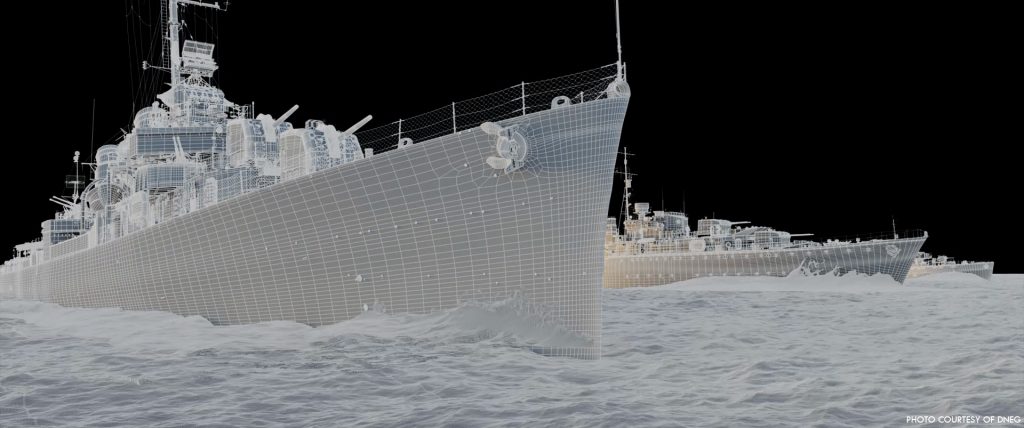
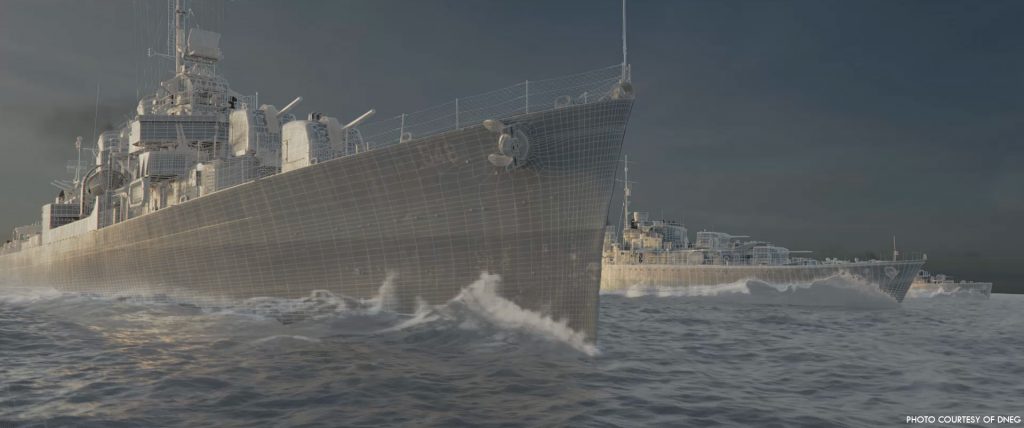
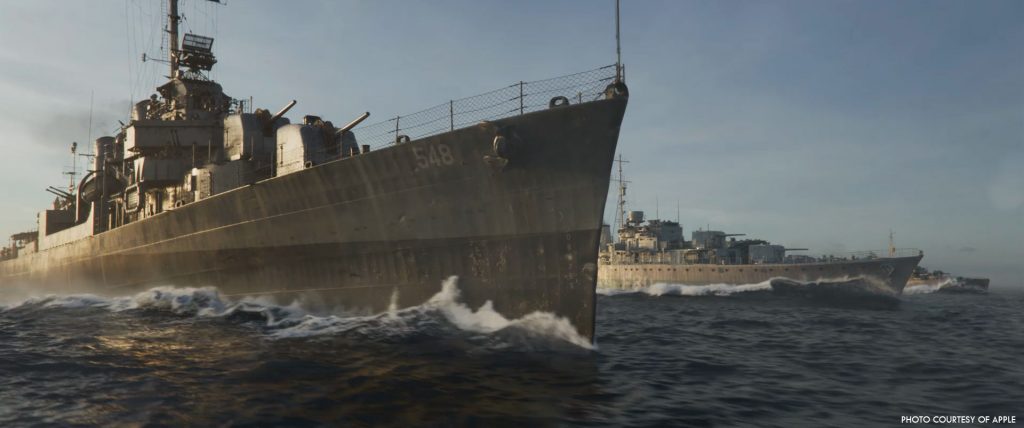
How did you prevent your render farm from burning?
Pete Bebb // From day one on this show we were very aware of the time. Consequently pipeline and shot methodology were critical. We designed an entire new layout pipeline that allowed us to procedurally run matchmove cameras directly into an animated and lit scene to render it. This could also be automated to run through a sequence comp script to give us an entire shot or sequence for dailies the next day. This type of automation ran through multiple areas of the film to allow us to streamline the process. To aid in settling the look of the film we broke down the entire show via shot type. Categorising the level of difficulty of all of them. Then we chose a shot category from each sequence and fast tracked it to final. This then gave the crew a shot to match to for all other similar types of shot with a given sequence. For example; there are scores of shots looking out at the bow crashing into the water from the bridge. Once one shot was fast tracked the rest were matched to that final
Can you elaborate on the creation of the various boats, planes and of course the U-boats?
Nathan McGuinness // There was no formula to recreate the Plane, Boats and U-Boats! In depth conversations with Gordon Laco (Naval Consultant) and the filmmakers and again, a ton of research to catalog the build and destruction of the Planes, Boats and U-Boats cherry picking the most specific ships / planes for the hero shots. We were very respectful not to overlook the DNA of these magnificent vessels.
Pete Bebb // Some data came from the previous vendor eventually – images and some lidar scans – but most was good old fashioned research from both ourselves, Nathan and the Naval Advisor. Old school means of undertaking CG asset creation. We thought it would be apt to go and have a group visit to the HMS Belfast at London Bridge – to understand the scale of these vessels but also the level of detail and construction of them. We also learnt Morse Code too! 😉 The build of the hero vessel the USS Kidd (Greyhound) was a huge undertaking which took literally the duration of the show to complete. The shots were continually being updated with the latest asset to make the most from the improvements the team had made. By the time the asset was finished you could graze the entire exterior structure to within a few inches. It was a phenomenal asset. This is reflected in the opening shot.
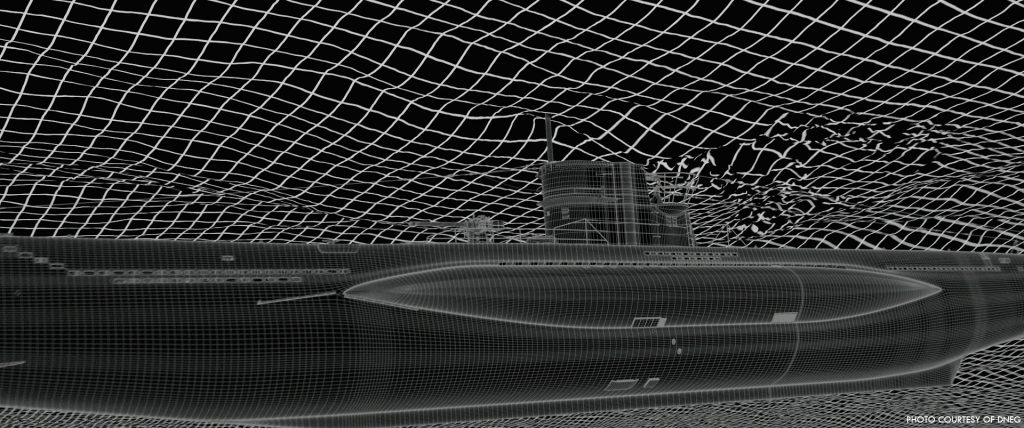
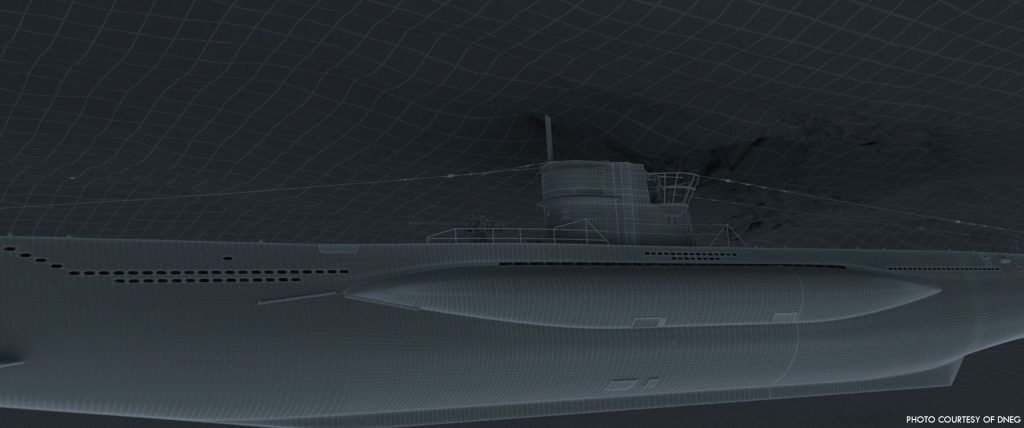
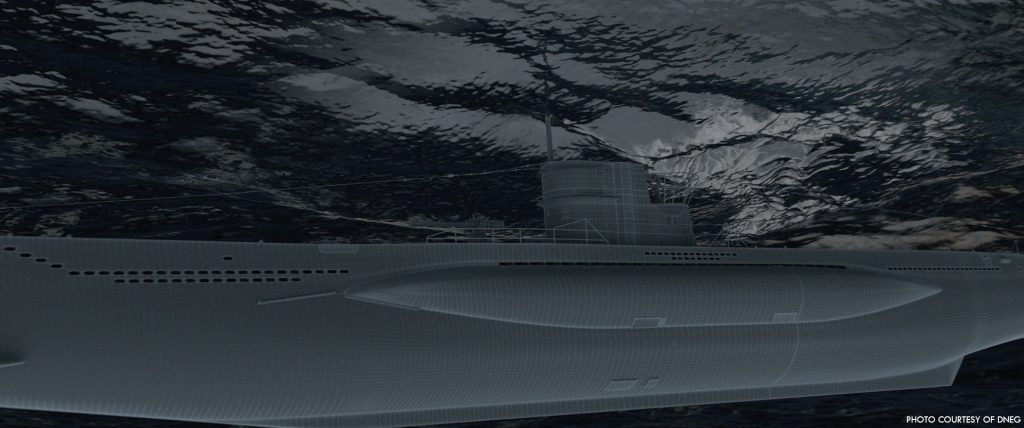
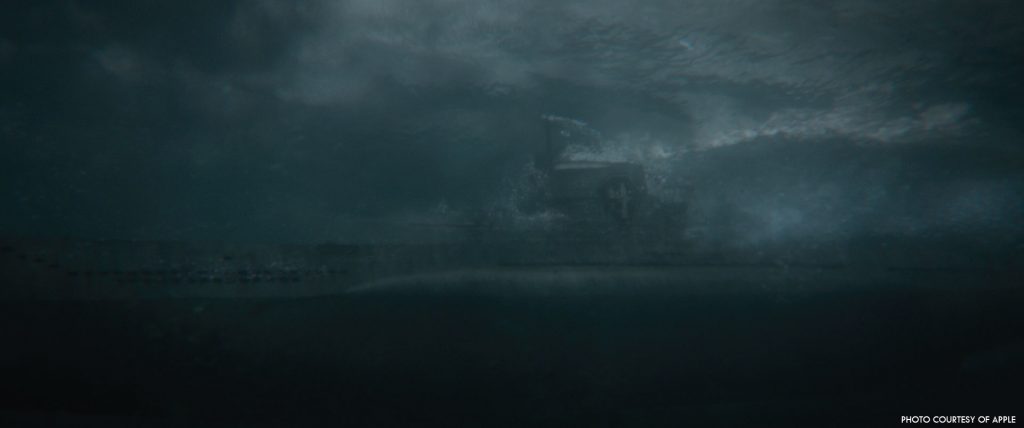
How did you create the various shaders and textures?
Nathan McGuinness // Researching and collecting photography of various degrees of aging, damage, color schemes, lighting iteration to oversee the skin of the vessels in every phase of their journey.
Pete Bebb // Textures were created via multiple means from shooting the real USS Kidd to assessing the light on the HMS Belfast. A lateral thinking approach had to be undertaken for this task as not being part of the original VFX crew we did not have the usual amount of data we require.
How did you populate the boats with crew?
Pete Bebb // Some crew was shot against greenscreens on a 1.1 buck build. We did get that from the production but then we had to build some digi doubles to allow for mid/wide shots. There was a limited reliance on CG extras as the budget did not allow for this. No hero Tom Hanks for example. It is a better film for it in my opinion – I am not a huge fan of digi-doubles.
Can you tell us more about the various explosions?
Nathan McGuinness // Again live footage as reference was key! There is a big difference between the way a merchant ship carrying certain supplies e.g fuel explodes compared to a merchant ship carrying food supplies. Also the location of impact, first and secondary explosions; day vs night explosions. Explosions caused by guns firing from the destroyer vs depth charges would react completely differently. The german U-Boat with their torpedoes had a life of their own. Each explosion had its own beautiful aesthetic. Especially at night given there was almost zero visibility until… boom!
Pete Bebb // Explosions are all CG with reference to real war footage for the specifics. For example; the muzzle flash of a Bofor gun was matched to for period accuracy. For the main explosions we referenced both stock footage and the DNEG explosion element library. A combination of the two. For the most part though we matched to stock – actual filmed footage of depth charges matched in FX and then signed off in side by side comparison for the client. This methodology was conducted across the board for all explosions and ordnance.
How did you handle the lighting challenges especially for the night sequences?
Nathan McGuinness // The only way for the convoy to travel undetected across the Atlantic safely at night was in total darkness. Not even a cigarette was allowed to be lit! It was a bling game of chess. I sat in the dark imagining the strategic game played – a game in the dark which had to be translated for the audience. The moon being the main source of light we designed a shots
Pete Bebb // As before the HDR time lapse material set the tone and real world environment. This was physically correct. But as you can imagine the actual illumination at night in the middle of the Atlantic is minimal. It is basically the moon. This obviously presented some problems from a narrative perspective. We want this to be completely visceral and real for the subject matter but we also want to be able to tell the story and actually see the ships. It was a dilemma. Escorts did clip convoy vessels, this actually happened under wartime black out conditions. Nathan mentioned you could be in serious trouble as a sailor for having a cigarette out on deck for example. So this gives you some idea of just how dark it was.
Of course we first created the scenes like this, very true to the environment and wartime scenario. They were brutally real, very dark and immensely atmospheric with what you could not see. What was decided though was to increase the moon contribution by a half stop to a stop in the shot so DI could then have something to play with. Of course the reliance of external lighting sources was key too, flares, explosions, tracer fire all lit the scene in a way that was very authentic. It was a very enjoyable experience developing the night time look as it was for the day time too.
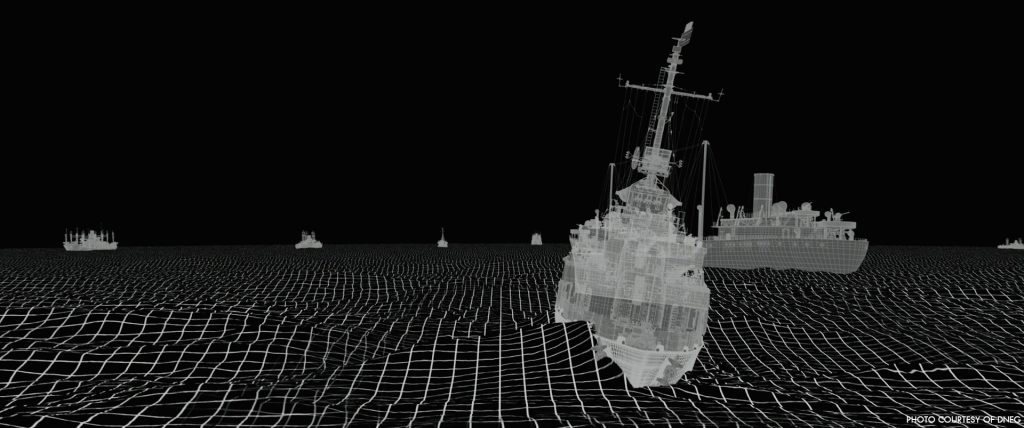
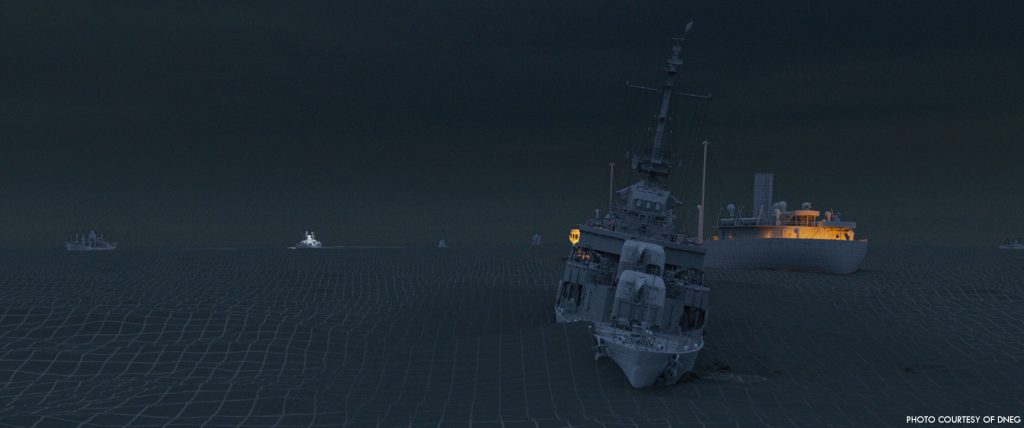
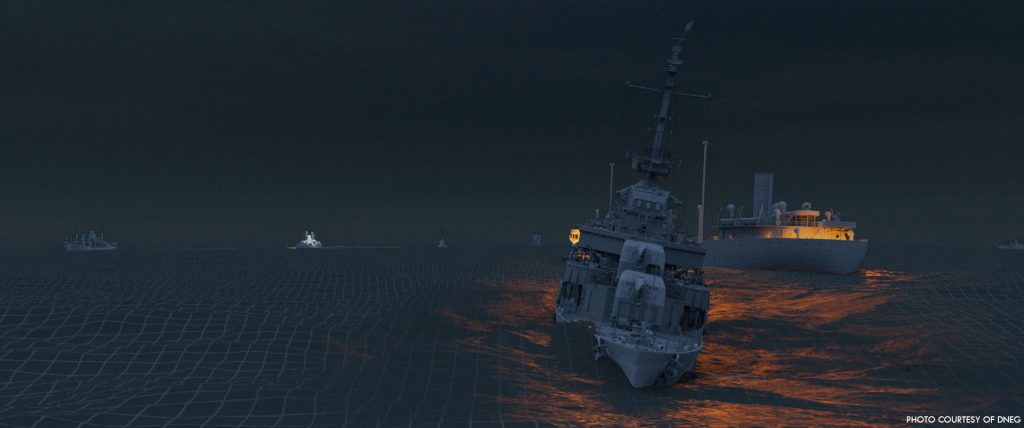
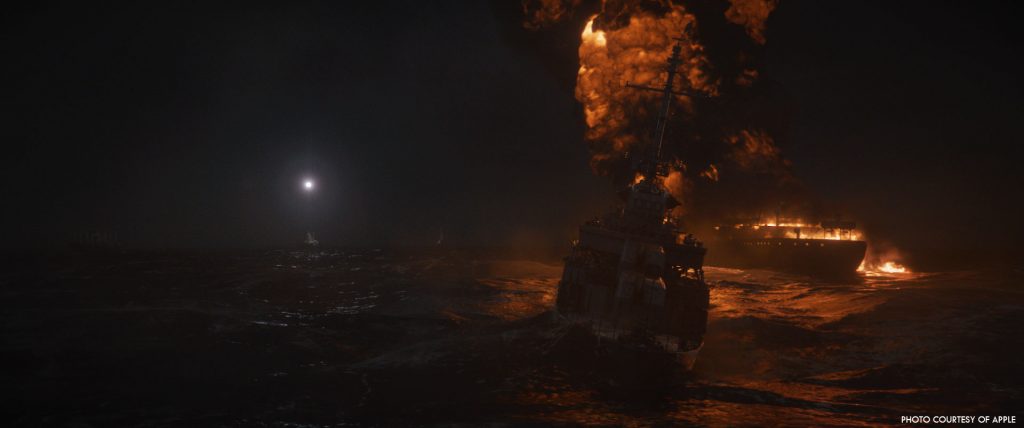
What were the main challenges with the underwater shots?
Pete Bebb // In a similar way to creating the night time look the underwater look was also a challenge. The challenge was the physically correct versus the narrative. At night under water in the Atlantic you’d see barely anything – a few meters ahead if that. But we need to see the U-boats launch torpedoes, we needed to see what U-boat it was etc. We opted to use more environment light from above, from explosions to ambient moonlight. Any means from a literal physical based source.
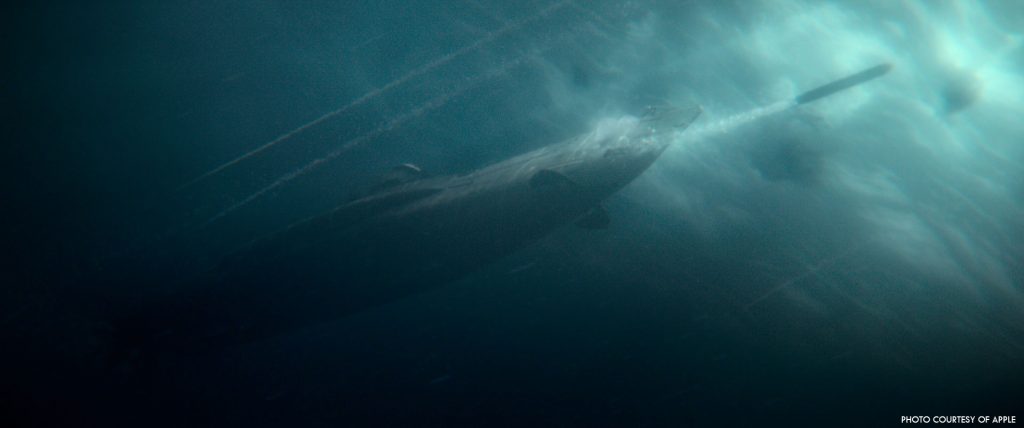
Some shots are really long. How does that affect your work?
Pete Bebb // It only affects the turnaround from a logistical point of view, increased animation time, increased simulation time and increased render time etc. Basically all departments are affected. But we incorporated the stages system on this show and instructed the client that we had to adhere to it to complete on time. So once approved at each stage there was no turning back. Stages being layout, anim, FX, final cg comp etc..
Which sequence or shot was the most challenging?
Pete Bebb // There was no specific sequence for me or shot. The entire show was a challenge from a time aspect and maintaining authenticity and quality. That is also what made doing the job so much fun.
Is there anything specific that gave you some really short nights?
Pete Bebb // We handpicked the DNEG crew for this one, I would like to say they are the A Team. So there were no real worries, but just real challenges that we knew we could overcome. The prospect was slightly ridiculous in hindsight. Approximately 1500 shots with full CG environments with no assets and no time. What more do you want to keep you on your game? When the scenario is this challenging all you can do is knuckle down.
What is your favorite shot or sequence?
Pete Bebb // PBO_0270, see I even remember the shot name. Wide angle lens on the bow of the ship as it fires its 5inch guns directly into camera. Looked great. I am also very partial to the bow wave crashing shots from the bridge. They just looked like the period footage, cold, overcast and slightly daunting. Just a huge shame that it was never released on the big screen. This show was shot for it.
What is your best memory on this show?
Pete Bebb // The client and the team. Forgive the pun, but it was an ‘all hands on deck’ adventure that paid off. What more do you want in this job.
How long have you worked on this show?
Pete Bebb // First introduced to the client in October, we delivered the show in February with some additional last minute shots going into March. The majority of the 25 sequences, approx. 1500 shots, were undertaken in under 4 months.
What’s the VFX shot count?
Pete Bebb // Approximately 1500.
What was the size of your team?
Pete Bebb // Approximately 500+ but I do not have exact numbers. I had teams in Mumbai, Vancouver and London.
What is your next project?
Pete Bebb // Infinite with Mark Wahlberg and directed by Antoine Fuqua.
What are the four movies that gave you the passion for cinema?
Pete Bebb // The Empires Strikes Back. Dune. Alien. Jaws.
There are far more than that of course….the list goes on…
A big thanks for your time.
Greyhound – Behind the Scenes VFX Breakdown – Apple TV+
WANT TO KNOW MORE?
DNEG: Dedicated page about Greyhound on DNEG website.
Apple TV+: You can watch Greyhound on Apple TV+ now.
© Vincent Frei – The Art of VFX – 2021





Is there any chance of Greyhound, going over to DVD or blue Ray in the near future?
Hi John, unfortunately there is no information on this subject at the moment.